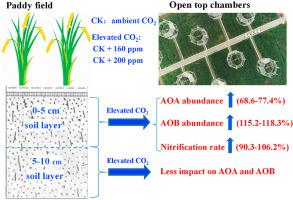Environmental Pollution ( IF 8.9 ) Pub Date : 2021-06-09 , DOI: 10.1016/j.envpol.2021.117558 Li-Dong Shen 1 , Yu-Ling Yang 1 , Jia-Qi Liu 1 , Zheng-Hua Hu 1 , Xin Liu 1 , Mao-Hui Tian 1 , Wang-Ting Yang 1 , Jing-Hao Jin 1 , Hao-Yu Wang 1 , Yuan-Yuan Wang 1 , Hong-Sheng Wu 2

|
The elevated atmospheric CO2 concentration is well known to have an important effect on soil nutrient cycling. Ammonia oxidation, mediated by ammonia-oxidizing archaea (AOA) and ammonia-oxidizing bacteria (AOB), is the rate-limiting step in soil nitrification, which controls the availability of two key soil nutrients (ammonium and nitrate) for crops. Until now, how the AOA and AOB communities in paddy soils respond to elevated CO2 remains largely unknown. Here, we examined the communities of AOA and AOB and nitrification potential at both surface (0–5 cm) and subsurface (5–10 cm) soil layers of paddy fields under three different CO2 treatments, including CK (ambient CO2 concentration), LT (CK + 160 ppm of CO2) and HT (CK + 200 ppm of CO2). The elevated CO2 was found to have a greater impact on the community structure of AOB than that of AOA in surface soils as revealed by high-throughput sequencing of their amoA genes. However, no obvious variation of AOA or AOB communities was observed in subsurface soils among different CO2 treatments. The abundance of AOA and AOB, and nitrification potential were significantly increased in surface soils under elevated CO2. The variation of AOB abundance correlated well with the variation of nitrification potential. The soil water content and dissolved organic carbon content had important impacts on the dynamic of AOB communities and nitrification potential. Overall, our results showed different responses of AOA and AOB communities to elevated CO2 in paddy ecosystems, and AOB were more sensitive to the rising CO2 concentration.
中文翻译:

水稻土中氨氧化古菌和细菌对CO2浓度升高的不同反应
众所周知,大气 CO 2浓度升高对土壤养分循环具有重要影响。氨氧化由氨氧化古细菌 (AOA) 和氨氧化细菌 (AOB) 介导,是土壤硝化的限速步骤,控制着作物对两种关键土壤养分(铵和硝酸盐)的可用性。直到现在,稻田土壤中的 AOA 和 AOB 群落如何对升高的 CO 2做出反应仍然很大程度上未知。在这里,我们检查了在三种不同的 CO 2处理下,包括 CK(环境 CO 2浓度)下稻田表层(0-5 cm)和地下(5-10 cm)土壤层的 AOA 和 AOB 群落和硝化潜力, LT (CK + 160 ppm CO 2) 和 HT (CK + 200 ppm CO 2 )。通过对amo A 基因的高通量测序发现,升高的 CO 2对 AOB 群落结构的影响大于表层土壤中的 AOA 。然而,在不同的CO 2处理下,地下土壤中没有观察到AOA或AOB群落的明显变化。CO 2升高的表层土壤中AOA和AOB的丰度和硝化潜力显着增加. AOB丰度的变化与硝化势的变化密切相关。土壤含水量和溶解有机碳含量对AOB群落动态和硝化潜力有重要影响。总体而言,我们的结果显示 AOA 和 AOB 群落对水稻生态系统中CO 2升高的反应不同,并且 AOB 对 CO 2浓度升高更敏感。

























 京公网安备 11010802027423号
京公网安备 11010802027423号